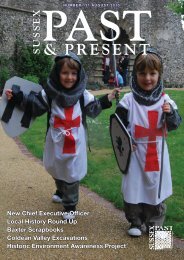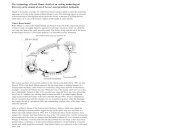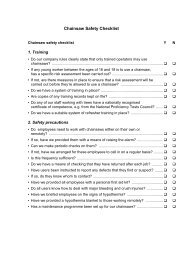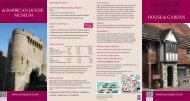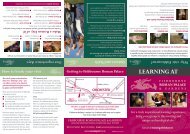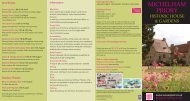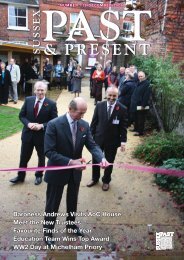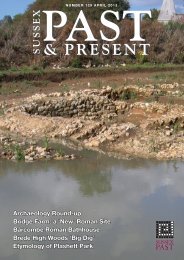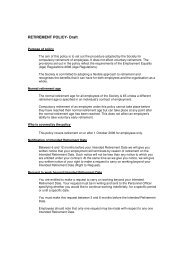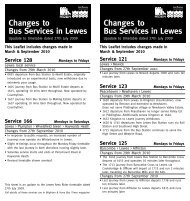April 2008 (issue 114) - The Sussex Archaeological Society
April 2008 (issue 114) - The Sussex Archaeological Society
April 2008 (issue 114) - The Sussex Archaeological Society
You also want an ePaper? Increase the reach of your titles
YUMPU automatically turns print PDFs into web optimized ePapers that Google loves.
Research<br />
FISHBOURNE ROMAN PALACE<br />
LEWES PROPERTIES<br />
Development<br />
Animals as status symbols<br />
Pigs and cattle in Iron Age/Roman West <strong>Sussex</strong><br />
<strong>The</strong> role of animals in archaeology<br />
has traditionally been<br />
thought of from an economic perspective,<br />
with animal bone reports<br />
highlighting ‘calories consumed’ or<br />
‘yields produced’. More recently,<br />
the social importance of animals,<br />
as in ritual practices, ethnic values<br />
or symbolically in art, have been<br />
emphasised.<br />
So what does this mean for our<br />
understanding of Iron Age/Romano-<br />
British rural identities Over the<br />
transitional period, pig remains<br />
constitute high levels at higherstatus<br />
sites such as Fishbourne<br />
Roman Palace and the Romano-<br />
Celtic temple on Hayling Island.<br />
<strong>The</strong> links between these two sites<br />
are well known, as are their cultural<br />
connections with the continent.<br />
Contrastingly, lower-status<br />
farmsteads were mainly herding<br />
cattle and sheep at this point, possibly<br />
linked to the production of<br />
secondary commodities vital to a<br />
subsistence lifestyle. Into the later<br />
Roman period, the political geography<br />
seems to have shifted from<br />
the royal core at Fishbourne, which<br />
declined and was eventually abandoned,<br />
to a new, decentralised<br />
rural elite based across the South<br />
Downs. At all these wealthy villas<br />
cattle seem to have been the key to<br />
economic success, as exemplified<br />
by the villa at Bignor, West <strong>Sussex</strong><br />
which contained nearly 80% cattle<br />
remains in its bone assemblage.<br />
<strong>The</strong> role of Chichester as a regional<br />
commercial catalyst is significant<br />
and, at first glance, these changes<br />
look economic in design. But we<br />
must remember that this is only an<br />
abstract observation by ourselves,<br />
modern enthusiasts, looking back<br />
into the past! What were the experiences<br />
of people living at that time<br />
How did they understand the world<br />
around them Is it possible that different<br />
animals were imbued with<br />
different meaning In the earlier<br />
period the evidence suggests the<br />
activities of procuring, killing and<br />
consuming pigs could have been<br />
an identifier of elitism, prescribing<br />
a representation of social position.<br />
Though, over time, it seems that<br />
cattle became symbolic indicators<br />
of wealth on villas. So a change in<br />
perception of animals in relation<br />
to the people who interacted with<br />
them could give us ideas as to how<br />
the living world in the late Iron Age<br />
and Roman period was symbolic<br />
and representational.<br />
<strong>The</strong>se are only early indications<br />
and broader <strong>issue</strong>s still need to<br />
be addressed, but I hope that this<br />
discussion is beginning to highlight<br />
the importance of animal remains<br />
in local archaeology. <strong>The</strong> <strong>Sussex</strong><br />
data certainly shows that they were<br />
primary to local and regional economies.<br />
Though maybe we should<br />
also view animals as being part of<br />
wider, more complex, cultural perceptions<br />
….<br />
Martyn Allen<br />
PhD Research Student<br />
Martyn will be talking about Zooarchaeology<br />
and Romanisation at<br />
Fishbourne Roman Palace on <strong>April</strong><br />
26 (see Noticeboard for details).<br />
Palaeolithic site at Beedings<br />
Flintwork from Beedings.<br />
Photo: C Wells<br />
H<br />
ow old is this flintworking<br />
Summer 2007 saw trial<br />
trench excavations by Matt Pope<br />
and a volunteer team in the field<br />
to the east of Beedings Castle,<br />
Nutbourne, near Pulborough, West<br />
<strong>Sussex</strong>. This revealed flintworking<br />
in a fissure in the greensand (Hythe<br />
Beds) bedrock, in fine sediments<br />
perhaps consisting of loess (periglacial<br />
wind-blown sand). <strong>The</strong> key<br />
question is whether some of the<br />
flint working is Upper Palaeolithic<br />
or some is perhaps even Late<br />
Middle Palaeolithic, and if so these<br />
assemblages may cover the period<br />
when the last Neanderthal hunters<br />
of the British Isles were replaced by<br />
early “modern” peoples.<br />
Further excavations planned for<br />
the summer of <strong>2008</strong> will, we hope,<br />
throw more light on this site. It will<br />
also form the basis of an English<br />
Heritage funded review of potential<br />
for similar sites fringing the Weald,<br />
to be carried out by the Boxgrove<br />
Project in the coming year. More<br />
news in the summer newsletter.<br />
Matt Pope<br />
UCL<br />
Caroline Wells<br />
Chair of Council<br />
Developments in Lewes<br />
Sally White reports on Anne of Cleves and Castle Appeals<br />
<strong>The</strong> plans for Lewes Castle and<br />
Barbican House are gathering<br />
momentum, though not unexpectedly<br />
there are some setbacks as<br />
well as successes along the way.<br />
I am stunned by and very grateful<br />
for the response many of you<br />
made to the appeal for books to<br />
put in our book sale for the Castle<br />
Appeal. <strong>The</strong> sale took place in February<br />
and was a great success. We<br />
had so many books that the sale<br />
was extended to three days and we<br />
took over £1200. This total will rise<br />
as there are lots of books left and<br />
John Bleach will be finding homes<br />
for many of them. Hopefully this will<br />
pay for three new steps.<br />
In December 2007 we heard that<br />
we have been given Planning Permission,<br />
Scheduled Monument<br />
Consent and Listed Building Consent<br />
for all of the structural works<br />
in the project, subject to a few conditions.<br />
I was hugely relieved, and<br />
the Lewes District Councillors were<br />
unanimous in their warm support<br />
of our plans. A second application,<br />
covering new signs on the outside<br />
of Barbican House and the display<br />
boards in the Castle will be considered<br />
shortly. <strong>The</strong> Heritage Lottery<br />
Fund (HLF) insisted on the commissioning<br />
of a Conservation Management<br />
Plan, which is being prepared<br />
by a team of consultants and we<br />
will get the first draft shortly. It will<br />
be a fascinating and useful document<br />
summarising the history and<br />
importance of the properties and<br />
setting out a 10-year maintenance<br />
plan.<br />
I am trying to identify an individual<br />
or group who can help with the<br />
refurbishment of the Lewes Town<br />
Model. I have started discussions<br />
with a local model railway society<br />
but would be grateful for any suggestions<br />
of people who might be<br />
able to help with this. <strong>The</strong> Model<br />
needs thorough and careful cleaning,<br />
repairs to buildings and streets,<br />
replacing parts of the railway and<br />
re-flocking of the trees.<br />
<strong>The</strong> next important date is in<br />
March (we do not know the exact<br />
date) when the HLF will consider<br />
our Stage 2 Submission. Once they<br />
give the project the final go ahead,<br />
we hope to start work on site in<br />
October <strong>2008</strong>, and the Castle will<br />
probably close for six months while<br />
all the outdoor work is completed.<br />
Fundraising<br />
Shortly before Christmas the<br />
Appeal got a serious boost when<br />
we heard that grant applications<br />
to the Wolfson Foundation and<br />
the Garfield Weston Trust had<br />
been successful. We are waiting<br />
for responses from several other<br />
grant-giving organisations. Largely<br />
because English Heritage has introduced<br />
new conditions, such as lead<br />
roofs for the Education Resource<br />
Centre and Interpretation Pavilion,<br />
the costs of the project have gone<br />
up. Our new fund raising target is<br />
£177,000 – double what we originally<br />
thought. On the bright side<br />
we have now raised over £50,000.<br />
A heartening number of donations<br />
has been coming in from members,<br />
and some smaller donations will be<br />
combined so that some of the steps<br />
can be credited to ‘Members of the<br />
<strong>Sussex</strong> <strong>Archaeological</strong> <strong>Society</strong>’ on<br />
the engraved bricks.<br />
Anne of Cleves House<br />
<strong>The</strong> HLF project has not distracted<br />
us from the clamant needs of Anne<br />
of Cleves. We are very aware that<br />
urgent repairs are needed to the<br />
rainwater goods, roof, timbers and<br />
windows. Trustee Richard Akhurst<br />
prepared a schedule of works that<br />
has gone out to local builders and<br />
we are considering tenders from<br />
two firms.<br />
Gutters, Anne of Cleves House.<br />
Jane Vokins, Chairman of the<br />
Friends of Anne of Cleves, has put<br />
in a huge amount of effort to source<br />
grants to help fund these essential<br />
works. Leaving no stone unturned,<br />
she discovered that the climax of<br />
the annual National Maintenance<br />
Week in November is National<br />
Guttering Day (I’m sure you are<br />
all rushing to put the date in your<br />
diaries). Fortuitously the organisers<br />
are looking for a building with<br />
suitably decrepit gutters to pose<br />
a celebrity against as part of their<br />
publicity campaign. Not to miss an<br />
opportunity, Jane has offered them<br />
Anne of Cleves House. It certainly<br />
has an abundance of decayed<br />
guttering (see photo above).<br />
We are trying to raise money to<br />
help to pay for these repairs and to<br />
minimise the amount the <strong>Society</strong><br />
has to dip into its reserves. Although<br />
I have been encouraging you all to<br />
help with the Castle Appeal, I would<br />
also ask anyone who cares about<br />
the future of this really important<br />
Wealden House, or who may have<br />
personal memories of it, to make<br />
any contribution they can.<br />
8 <strong>Sussex</strong> Past & Present <strong>April</strong> <strong>2008</strong><br />
www.sussexpast.co.uk www.romansinsussex.co.uk <strong>Sussex</strong> Past & Present <strong>April</strong> <strong>2008</strong> 9<br />
Photo: S White



